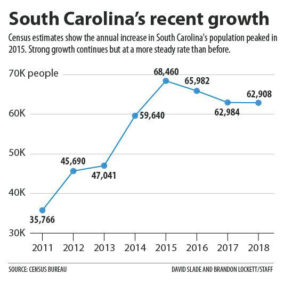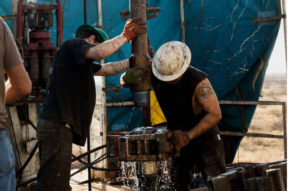Seven Colleges & Universities.
With seven institutions of higher learning and more than 11,000 total college students, Spartanburg is a College Town. Each of those institutions, both on their own and often in partnership with one another, provide opportunities not only for their students but also for the entire Spartanburg community. From Division I sports and cultural events to continuing education opportunities and notable visiting speakers, Spartanburg residents enjoy access to everything that you would expect from the best colleges and universities.
Spartanburg’s large and growing student population means there is always something fun to do — and that the local economy is always on the move. From an abundance of potential new, young customers to opportunities for internships and research, if you own a business in Spartanburg, our colleges and universities present a huge opportunity.
 Some of South Carolina’s population growth hot spots have cooled, according to just-released census estimates, but new residents continued to pour in to Horry and Berkeley counties, the counties adjacent to Charlotte, and — perhaps surprisingly — Spartanburg.
Some of South Carolina’s population growth hot spots have cooled, according to just-released census estimates, but new residents continued to pour in to Horry and Berkeley counties, the counties adjacent to Charlotte, and — perhaps surprisingly — Spartanburg.
The Palmetto State has been a fast-growing region for years and that continued through mid-2018. The state added 62,908 residents. More than 80 percent of the growth came from people relocating from other states, the Census Bureau estimated. Continued at postandcourrier.com
 Not long ago, in Spartanburg, S.C., I visited the offices of something called the Spartanburg Academic Movement (SAM). The walls were lined with charts measuring things like kindergarten readiness, third-grade reading scores and postsecondary enrollment.
Not long ago, in Spartanburg, S.C., I visited the offices of something called the Spartanburg Academic Movement (SAM). The walls were lined with charts measuring things like kindergarten readiness, third-grade reading scores and postsecondary enrollment.
Around the table was just about anybody in town who might touch a child’s life. There were school superintendents and principals, but there were also the heads of the Chamber of Commerce and the local United Way, the police chief, a former mayor and the newspaper editor. Continued at nytimes.com
 We are often told that America’s future lies in our big cities. That may no longer be entirely true. Some of the strongest job creation and population growth is now occurring in cities of 1 million people or less.
We are often told that America’s future lies in our big cities. That may no longer be entirely true. Some of the strongest job creation and population growth is now occurring in cities of 1 million people or less.
In this year’s edition of our Best Cities For Jobs survey, we found that six of the 10 metropolitan areas with the fastest job growth are either mid-sized (150,000 to 450,000 total nonfarm jobs) or smaller (less than 150,000 nonfarm jobs). They also account for 18 out of the top 30. Smaller metro areas dominated job growth in a number of sectors, including manufacturing (all the top 20), information (all of the top 10) jobs and, less surprisingly, natural resources, construction and mining. Continued at forbes.com
